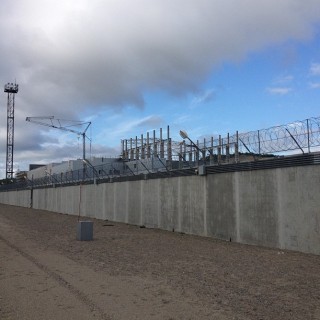
New Managing Director for Bellona Norway
The Board of the Bellona Foundation has appointed former Minister of Climate and the Environment Sveinung Rotevatn as Managing Director of Bellona No...
News

Publish date: September 23, 2014
Written by: Anna Kireeva, Anna Kireeva, Charles Digges
News
MURMANSK – The past decades of international support for projects aimed at cleaning up Russia’s Cold War nuclear legacy in the Arctic have met resounding success, but there still far more that needs to be done. To what extent will Moscow’s recalcitrant stance on the world stage scuttle those needed efforts?
Anatoly Grigoriev, head of coordinating and implementing international programs for eliminating and rehabilitating nuclear hazards with Russia’s state nuclear corporation Rosatom, the exhaustive list of priority projects in the Murmansk Region include the former naval spent nuclear fuel site at Andreyeva Bay, the Gremikha naval radioactive waste storage site, the stalled dismantlement of the Lepse nuclear service ship, nuclear submarine spent nuclear fuel storage, the fate of nuclear technical services in the area, as well as dealing with nuclear powered battle cruisers and surface ships – which are 10 times as costly as decommissioning nuclear submarines.
To top it off, the Russian Ministry of Defense, in a fit of jingoism, is dumping more money into new nuclear submarine lines than was ever allocated for dismantling Cold War nuclear hazards.
But Grigoriev was keeping a stiff upper about universal hostility directed at Moscow over its military incursions into eastern Ukraine when he spoke at last week’s 10th Socio-Environmental Congress in Arkhangelsk.
“International cooperation allowed for a significant reduction in the time it took to make decisions about problems remained at the end of the last century,” he said. “I am sure that already secured contracts will not be affected as a result of current sanctions.” Indeed, the sanctions target Russia’s sorest spot and biggest money-spinner – natural gas. But it may, say some, be only a matter of time before Russia’s nuclear ambitions, especially in Eastern Europe, where Rosatom has handed out billions of dollars in reactor construction credits.
Grigoriev continued, saying, “In 2007, our experts were convinced that €2 billion would be sufficient to deal with the nuclear legacy on the Kola Peninsula. However, we have by now spent €2.5 billion and we continue to solve the problems.”
Andreyeva Bay
When speaking of the most difficult and controversial subject of Andreyeva Bay, Grigoriev noted that since the beginning of work there in 2001, all projects addressing the development infrastructure facilities have been completed.
Yet, of 22,000 spent fuel assemblies, merely 292 have been evacuated from the site. But work at the site is now turning to solid radioactive waste that is stored in the open air. Some 359 cubic meters of the 18,000 housed at Andreyeva Bay have been taken to storage at Sayda Bay.
According to Vladimir Khandobin,, head of the Liquidation of the Arctic Nuclear Legacy engineering office of RosRAO, Russia’s state enterprise for handling nuclear waste, the most daunting task at Andreyeva Bay is the construction of a shelter protecting dry storage units and beginning the removal of spent fuel, with the help of vessels from Murmansk’s Atomflot port, to the Mayak Chemical Combine in the landlocked Urals in Chelyabinsk.
Gremikha
Grigoriev reported there has been significant improvement in the general radiation environment at Gremikha, as was noted by Bellona Murmansk’s director Andrei Zolotkov noted during a recent trip of the Murmansk Region’s Public Council on Nuclear Safety.

The site of the technical base has been entirely cleared of spent nuclear fuel from the pressurized water reactors of decommissioned submarines, a total of 898 spent fuel assemblies, and spent removable parts from liquid metal cooled reactors from Alpha Class nuclear submarines has also been removed.
Experts have developed two technologies, one for dealing with defective spent nuclear fuel, and another for disassembling removable irradiated reactor parts.
Currently, of all the backlogged volumes of solid radioactive waste situated at Gremikha, only 180 have been removed. Current plans up to 2020 envision the dismantlement of all spent removable irradiated reactor parts from the liquid metal cooled reactors, spent fuel unloading, and evacuation of all of this hazardous material to storage in the Murmansk Region and beyond.
RosRAO’s Khandobin said there are nine remaining liquid metal cooled reactors whose spend nuclear fuel needs to be removed and whose spent removable parts must be deal with, a job he anticipates will take the next five to six years.
Sayda Bay
In December this year, it’s anticipated that the construction of the Regional Center for Conditioning and Long-Term Storage of Radioactive Waste will be completed and delivered to the Russian side. The facility will have a 100,000 cubic meter capacity and a final price tag of €300 million.

Construction of the No 1 and 2 points for long-term storage of reactor compartments at Sayda Bay has been completed and 64 reactors of 120 present on site have been put into temporary storage. The points for long-term storage of reactor compartments are rated to hold single-chamber reactors for up to 70 years.
A scheme for depositing solid radioactive waste from ships and vehicles has been developed. Work is being conducted on blocks that house radioactive waste, and operations for dismantling the decommissioned Volodarsky nuclear service vessel.
The most critical remaining impediment to putting Northwest Russia’s nuclear legacy in the rearview mirror is dealing with nuclear waste – and entire submarines and reactors – dumped into Arctic seas by the Russian Navy over a five decade period ending in 1992, Grigoriev said.
But Grigoriev said that the chain of custody for these dumped radioactive materials are foggy and it’s hard to determine whose responsibility it is to raise them.
“They must be raised now – Rosatom has the capability of dealing with these installations, and some of the specialists who prepared them for dumping in the sea are still around,” he said.

The Board of the Bellona Foundation has appointed former Minister of Climate and the Environment Sveinung Rotevatn as Managing Director of Bellona No...

Økokrim, Norway’s authority for investigating and prosecuting economic and environmental crime, has imposed a record fine on Equinor following a comp...

Our op-ed originally appeared in The Moscow Times. For more than three decades, Russia has been burdened with the remains of the Soviet ...

The United Nation’s COP30 global climate negotiations in Belém, Brazil ended this weekend with a watered-down resolution that failed to halt deforest...